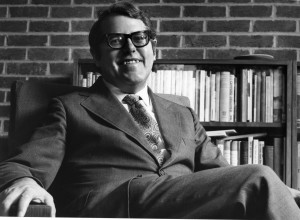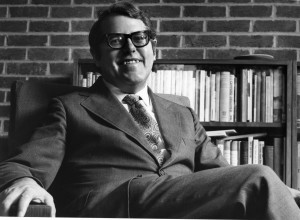Lord Briggs of Lewes (Asa Briggs) by Geoff Lockwood
The Trust lost one of its longest serving supporters when Lord Asa Briggs died peacefully at home in Lewes on 15th March.
Asa was the leading, and most prolific, social historian of his age, with a special interest in the Victorian period. He was also one of the most influential and innovative educationalists of his time.
His impact ranged from adult education (as a driving force in the creation of the Open University) to the highest levels of our universities, as the second Vice-Chancellor of the University of Sussex and, later, Provost of Worcester College, Oxford.
As a member of the National University Grants Committee he was instrumental in the birth in 1961 of Sussex as the first brand new university in England and especially its location in Brighton. Asa was fascinated by Brighton with its Victorian and Regency history and inheritance.
He was a great lover of the West Pier, which he came in direct contact with when he arranged with director Richard Attenborough to supply University of Sussex students as the bulk WW1 soldier extras for the movie Oh! What a Lovely War, which was filmed on the Pier.
When I was the Deputy Chairman and Chief Executive of the West Pier Trust in the decade from 1995, Asa was a major source of advice and support.
It is best to end with his own words from the foreword to Fred Gray’s 1998 book on the West Pier, Walking On Water. Although the optimism expressed was dashed by the later professional arson attacks, the piece reflects Asa’s love of piers and especially the West Pier.
Loving all piers, I have a particular love of the West Pier however, a love which goes back long before I was Vice-Chancellor of the University of Sussex and became associated with the struggle to retain it. There has always been a struggle. Piers are places of delight, but the effort to conserve them is relentless. Far too many have gone. Those that remain are among the richest elements in our heritage.
In itself their architecture is fascinating. So, too, is the aesthetics, bound up with style as well as with function – and, above all, with fun. Yet is has never been possible at any stage in their history, to separate aesthetics from economics. Piers have at least to pay for themselves. Seldom have they made great profits. They belong in a real sense to the people who use them. They are part of our social as well as our architectural heritage. For the socialhistorian, interested both in work and leisure … piers are unique witnesses to changing ways of life. And because those piers that remain are in danger, in pleading for any particular one we always have to think of its future and the opportunities that it offers, not just of the past.
I am proud to have been associated with the struggle for the West Pier in more than one phase and because I admire the determination and enterprise of the people who have led that struggle and have sought a realistic but imaginative outcome.
The Trust extends it’s deepest condolences to his wife and four children.



